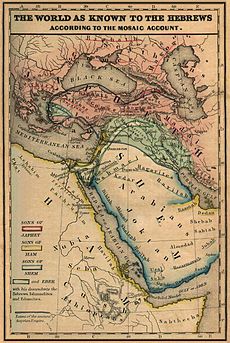

The Generations of Noah, also called the Table of Nations or Origines Gentium,[1] is a genealogy of the sons of Noah, according to the Hebrew Bible (Genesis 10:9), and their dispersion into many lands after the Flood,[2] focusing on the major known societies. The term 'nations' to describe the descendants is a standard English translation of the Hebrew word "goyim", following the c. 400 CE Latin Vulgate's "nationes", and does not have the same political connotations that the word entails today.[3]
The list of 70 names introduces for the first time several well-known ethnonyms and toponyms important to biblical geography,[4] such as Noah's three sons Shem, Ham, and Japheth, from which 18th-century German scholars at the Göttingen school of history derived the race terminology Semites, Hamites, and Japhetites. Certain of Noah's grandsons were also used for names of peoples: from Elam, Ashur, Aram, Cush, and Canaan were derived respectively the Elamites, Assyrians, Arameans, Cushites, and Canaanites. Likewise, from the sons of Canaan: Heth, Jebus, and Amorus were derived Hittites, Jebusites, and Amorites. Further descendants of Noah include Eber (from Shem), the hunter-king Nimrod (from Cush), and the Philistines (from Misrayim).
As Christianity spread across the Roman Empire, it carried the idea that all people were descended from Noah. Not all Near Eastern people were covered in the biblical genealogy (Iranic peoples such as Persians, Indic people such as Mitanni, and also others such as Greeks, Kassites, Sumerians and Hurrians are missing), as well as the Northern European and Western European peoples important to the Late Roman and Medieval world, such as the Celtic, Slavic, Germanic, and Nordic peoples; nor were others of the world's peoples, such as sub-Saharan Africans, Native Americans, Turkic and Iranic peoples of Central Asia, the Indian subcontinent, the Far East, and Australasia. Scholars later derived a variety of arrangements to make the table fit, with for example the addition of Scythians, which do feature in the tradition, being claimed as the ancestors of much of Northern Europe.[5]
According to the biblical scholar Joseph Blenkinsopp, the 70 names in the list express symbolically the unity of humanity, corresponding to the 70 descendants of Israel who go down into Egypt with Jacob at Genesis 46:27 and the 70 elders of Israel who visit God with Moses at the covenant ceremony in Exodus 24:1–9.[6]
- ^ Reynolds, Susan (October 1983). "Medieval Origines Gentium and the Community of the Realm". History. 68 (224). Chichester, West Sussex: Wiley-Blackwell: 375–390. doi:10.1111/j.1468-229X.1983.tb02193.x. JSTOR 24417596.
- ^ Rogers 2000, p. 1271.
- ^ Zernatto, Guido; Mistretta, Alfonso G. (July 1944). "Nation: The History of a Word". The Review of Politics. 6 (3). Cambridge University Press: 351–366. doi:10.1017/s0034670500021331 (inactive 1 November 2024). ISSN 1748-6858. JSTOR 1404386. S2CID 143142650.
{{cite journal}}: CS1 maint: DOI inactive as of November 2024 (link) - ^ "Biblical Geography," Catholic Encyclopedia: "The ethnographical list in Genesis 10 is a valuable contribution to the knowledge of the old general geography of the East, and its importance can scarcely be overestimated."
- ^ Johnson, James William (April 1959). "The Scythian: His Rise and Fall". Journal of the History of Ideas. 20 (2). Philadelphia: University of Pennsylvania Press: 250–257. doi:10.2307/2707822. JSTOR 2707822.
- ^ Blenkinsopp 2011, p. 156.